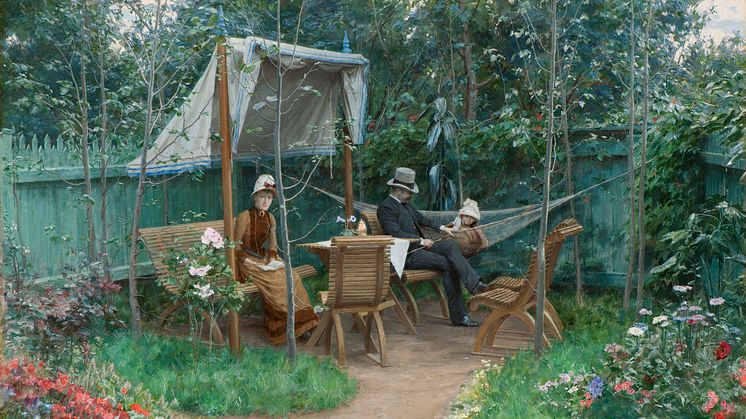
Press release -
New acquisition: Trädgårdsinteriör by Johan Krouthén
Nationalmuseum has acquired the painting Trädgårdsinteriör från Linköping by Swedish artist Johan Krouthén.The detailed painting depicts army surgeon Ernst Boman and his family and is dated 1887-1888. Nationalmuseum previously only owned one painting by Krouthén, and is thus pleased to be able to add this work from the artist’s best period.
Johan Krouthén (1858-1932)was part of the generation of artists that broke through during the 1880s, when a French-oriented realism dominated Swedish painting. However, in contrast to many of his contemporaries, Krouthén never spent any significant time in France in his youth. In the summer of 1883, he accompanied fellow artist Oscar Björck to Skagen and joined the colony of artists working there. In the 1880s, he took part in the opposition movement against the Royal Swedish Academy of Fine Arts and became a member of the newly formed Swedish Artists’ Association.
Johan Krouthén grew up in a middle-class family in Linköping and the painting acquired by the Nationalmuseum, dated 1887-1888, portrays an environment with which the artist was highly familiar. In the garden sits army surgeon Ernst Boman with his wife Mechtild and daughter Gudrun. The man and woman are elegantly dressed, but the poses of the figures and the apparently randomly placed garden furniture give the picture a relaxed and informal character. The technique is extremely precise and Krouthén has put a great deal of effort into accurately depicting the details of the scene. In the 1880s, Krouthén created several paintings with similar motifs from the Linköping area. The artist later came to be known chiefly for his prolific production of idyllic spring landscapes with red cottages and flowering fruit trees.
Nationalmuseum previously only owned one painting by Krouthén, and is thus pleased to be able to add this work from the artist’s best period. The painting was acquired using funds from the Hedda and N.D. Qvist Memorial Fund. Nationalmuseum does not have a budget for acquiring works to add to its art and design collections, instead relying on gifts and financial support from private foundations and funds.
Further information
Per Hedström, Assistant Director of Collections and the Swedish National Portrait Gallery, per.hedstrom@nationalmuseum.se, +46 8 5195 4356
Hanna Tottmar, press officer, hanna.tottmar@nationalmuseum.se, +46 8 5195 4390
Pressimages
www.nationalmuseum.se/pressroom
Categories

